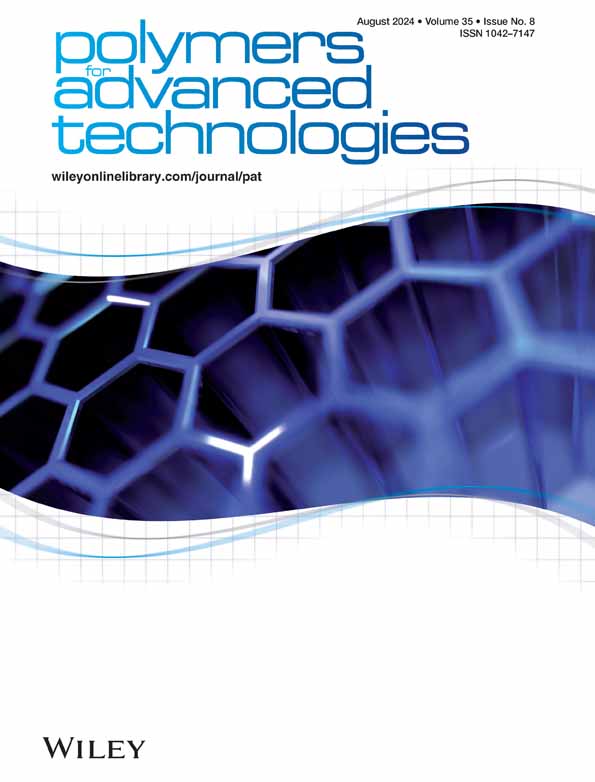A wideband flexible antenna utilizing PMMA/PVDF‐HFP/PZT polymer composite film and silver‐based conductive ink for wearable applications
IF 3.4
4区 工程技术
Q2 POLYMER SCIENCE
引用次数: 0
Abstract
The relentless drive towards miniaturization and seamless integration of electronic components in wireless communications and wearable devices has significantly increased the demand for flexible, cost‐effective composites with high dielectric constants and low losses. This study presents a wideband, low‐profile, and flexible antenna with excellent on body radiation performance for wearable applications. The antenna is designed using a low‐loss composite film based on PMMA‐PVDF‐HFP‐PZT and silver‐based ink. The proposed flexible antenna exhibits a wide bandwidth of 132.16% with a voltage standing wave ratio (VSWR) of less than two. It achieves a peak gain of 2.76 dBi at 2.92 GHz and maintains a maximum radiation efficiency of 80% across the 1.26–6.17 GHz frequency range. These characteristics demonstrate that the antenna is an effective solution for achieving high data rates and reliable communication links. The antenna's suitability for wearable applications is assessed by testing it on a simulated human body and analyzing its behavior under physical deformation. The results under bending showed only a minimal frequency detuning, which is negligible given the antenna's wide operational bandwidth. The specific absorption rate (SAR) analysis shows values of approximately 1.88 W/kg at 3.5 GHz with an input power of 0.5 W, and 0.279 W/kg at 5.8 GHz with an input power of 0.45 W, which complies with established safety limits for exposure. Overall, these results suggest that the proposed antenna is a viable solution for integration into wearable medical devices, such as a doctor's chest badge, enabling noncontact interactions and reducing the risk of bacterial contamination.利用 PMMA/PVDF-HFP/PZT 聚合物复合膜和银基导电墨水的宽带柔性天线,适用于可穿戴应用
随着无线通信和可穿戴设备向微型化和电子元件无缝集成方向的不断发展,对具有高介电常数和低损耗的柔性、高性价比复合材料的需求大幅增加。本研究提出了一种宽带、扁平、柔性天线,具有出色的人体辐射性能,适用于可穿戴应用。天线的设计采用了基于 PMMA-PVDF-HFP-PZT 和银基油墨的低损耗复合薄膜。所提出的柔性天线具有 132.16% 的宽带宽,电压驻波比(VSWR)小于 2。它在 2.92 GHz 频率下实现了 2.76 dBi 的峰值增益,并在 1.26-6.17 GHz 频率范围内保持了 80% 的最大辐射效率。这些特性表明,该天线是实现高数据速率和可靠通信链路的有效解决方案。通过在模拟人体上进行测试并分析其在物理变形下的行为,评估了该天线是否适合可穿戴应用。弯曲情况下的结果显示,频率失谐极小,考虑到天线的宽工作带宽,这种失谐可以忽略不计。比吸收率(SAR)分析表明,在输入功率为 0.5 W 的情况下,3.5 GHz 的比吸收率约为 1.88 W/kg;在输入功率为 0.45 W 的情况下,5.8 GHz 的比吸收率约为 0.279 W/kg,符合既定的安全暴露限值。总之,这些结果表明,拟议的天线是一种可行的解决方案,可集成到医生胸牌等可穿戴医疗设备中,实现非接触式交互,降低细菌污染的风险。
本文章由计算机程序翻译,如有差异,请以英文原文为准。
求助全文
约1分钟内获得全文
求助全文
来源期刊

Polymers for Advanced Technologies
工程技术-高分子科学
CiteScore
6.20
自引率
5.90%
发文量
337
审稿时长
2.1 months
期刊介绍:
Polymers for Advanced Technologies is published in response to recent significant changes in the patterns of materials research and development. Worldwide attention has been focused on the critical importance of materials in the creation of new devices and systems. It is now recognized that materials are often the limiting factor in bringing a new technical concept to fruition and that polymers are often the materials of choice in these demanding applications. A significant portion of the polymer research ongoing in the world is directly or indirectly related to the solution of complex, interdisciplinary problems whose successful resolution is necessary for achievement of broad system objectives.
Polymers for Advanced Technologies is focused to the interest of scientists and engineers from academia and industry who are participating in these new areas of polymer research and development. It is the intent of this journal to impact the polymer related advanced technologies to meet the challenge of the twenty-first century.
Polymers for Advanced Technologies aims at encouraging innovation, invention, imagination and creativity by providing a broad interdisciplinary platform for the presentation of new research and development concepts, theories and results which reflect the changing image and pace of modern polymer science and technology.
Polymers for Advanced Technologies aims at becoming the central organ of the new multi-disciplinary polymer oriented materials science of the highest scientific standards. It will publish original research papers on finished studies; communications limited to five typewritten pages plus three illustrations, containing experimental details; review articles of up to 40 pages; letters to the editor and book reviews. Review articles will normally be published by invitation. The Editor-in-Chief welcomes suggestions for reviews.
 求助内容:
求助内容: 应助结果提醒方式:
应助结果提醒方式:


